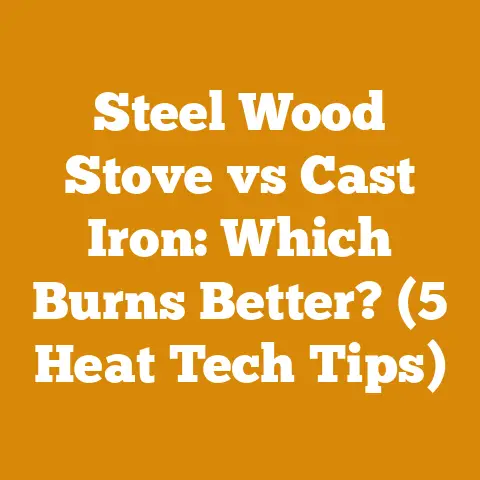Cast Iron Wood Stove Trivet: Essential or Overkill? (Wood Heat Hacks)
Let’s face it, the modern wood stove isn’t just about heating your home; it’s a statement. Sleek lines, glass doors, and even enameled finishes are becoming increasingly common. Amidst this blend of rustic charm and contemporary aesthetics, the question arises: Does a cast iron wood stove trivet still have a place? Is it an essential tool, or is it simply overkill? I’m going to dive deep into this question, exploring the practicality, benefits, and drawbacks of using a cast iron trivet on your wood stove. As someone who has spent years felling trees, processing wood, and relying on wood heat, I’ve got some insights to share that go beyond the surface level.
The State of Wood Heating Today
Before we get into the nitty-gritty of trivets, let’s set the stage. The wood heating industry is experiencing a resurgence, fueled by rising energy costs and a desire for self-sufficiency. According to the U.S. Energy Information Administration (EIA), approximately 12 million households in the United States use wood as a primary or secondary heating source. Globally, the numbers are even more significant, particularly in regions where access to electricity and fossil fuels is limited or expensive.
This renewed interest in wood heating has led to innovations in stove design, wood processing techniques, and even firewood storage methods. We’re not just talking about the old potbelly stoves anymore. Modern wood stoves are far more efficient, cleaner-burning, and aesthetically pleasing. But with these advancements, do traditional accessories like cast iron trivets still hold value?
Cast Iron Wood Stove Trivets: A Deep Dive
What is a Cast Iron Wood Stove Trivet?
A cast iron wood stove trivet is essentially a small, heat-resistant platform designed to sit on the surface of a wood stove. Its primary purpose is to create a buffer between the stove’s hot surface and anything placed on it, such as a kettle, pot, or even a cup of coffee. Trivets are typically made of cast iron due to its excellent heat retention and distribution properties.
Why Use a Trivet? The Benefits Unveiled
So, why might you consider using a cast iron trivet on your wood stove? Let’s explore the potential benefits:
-
Even Heat Distribution: Cast iron is renowned for its ability to distribute heat evenly. Placing a pot or kettle directly on the stove surface can create hotspots, leading to uneven heating and potential scorching. A trivet helps to mitigate this issue by spreading the heat more uniformly.
-
Protection for Stove Surface: While modern wood stoves are built to withstand high temperatures, repeated contact with cookware can still cause scratches, scuffs, and even enamel damage over time. A trivet acts as a protective barrier, preserving the aesthetic appeal of your stove.
-
Temperature Control: A trivet can give you a degree of temperature control. By elevating a pot or kettle slightly above the stove surface, you can reduce the intensity of the heat, preventing liquids from boiling over or simmering at too high a temperature.
-
Versatility: Beyond cooking, a trivet can be used to warm plates, thaw frozen foods, or even dry gloves and hats. I’ve used mine countless times to keep a pot of stew simmering gently throughout a long winter day.
-
Aesthetic Appeal: Let’s not forget the visual aspect. A well-chosen cast iron trivet can add a touch of rustic charm to your wood stove setup. There are countless designs available, from simple geometric patterns to intricate floral motifs.
The Other Side of the Coin: Potential Drawbacks
Of course, no product is without its drawbacks. Here are some potential downsides to consider before investing in a cast iron wood stove trivet:
-
Heat Transfer Reduction: While even heat distribution is a plus, a trivet also reduces the overall heat transfer to the item placed on it. This means it will take longer to boil water or heat up food compared to placing it directly on the stove surface.
-
Cleaning: Cast iron can be a bit of a pain to clean, especially if food spills onto it. You’ll need to season it regularly to prevent rust and maintain its non-stick properties.
-
Space Consumption: A trivet takes up space on your stove’s surface, which might be a concern if you have a smaller stove or frequently use multiple pots and pans simultaneously.
-
Cost: While not exorbitant, cast iron trivets can range in price from $20 to $50 or more, depending on the size, design, and brand.
-
Potential for Overheating: If you place a trivet on an already hot stove surface and then place a pot on the trivet, the trivet itself can become excessively hot, potentially posing a burn risk.
Is it Essential or Overkill? My Personal Take
After years of using wood stoves, I’ve come to the conclusion that whether a cast iron trivet is essential or overkill depends largely on your individual needs and preferences.
-
If you frequently cook on your wood stove: A trivet can be a valuable tool for achieving more even heating and protecting your stove’s surface.
-
If you primarily use your wood stove for heating: A trivet might be less essential, but it can still be useful for warming items or keeping a pot of water simmering.
-
If you have a modern wood stove with a catalytic combustor: You need to be careful not to block the catalytic combustor. In this case, a trivet may not be useful.
I personally find a trivet to be a worthwhile addition to my wood stove setup. I appreciate the added temperature control and the peace of mind it provides in terms of protecting my stove’s surface. Plus, I enjoy the rustic aesthetic it adds to my living room.
Choosing the Right Trivet: Factors to Consider
If you’ve decided that a cast iron trivet is right for you, here are some factors to consider when making your purchase:
-
Size: Measure the surface area of your wood stove to determine the appropriate size for your trivet. You want it to be large enough to accommodate your cookware but not so large that it takes up excessive space.
-
Design: Choose a design that complements the aesthetic of your wood stove and your home. Consider both the visual appeal and the functionality of the design. Some trivets have intricate patterns that can trap food particles, while others have a simpler, easier-to-clean design.
-
Material Quality: Opt for a trivet made of high-quality cast iron. Look for a smooth, even surface and a sturdy construction. Avoid trivets with cracks, chips, or other imperfections.
-
Heat Resistance: Ensure that the trivet is specifically designed for use on a wood stove and can withstand high temperatures.
-
Stability: Choose a trivet with a stable base that won’t wobble or tip over easily.
Maintaining Your Cast Iron Trivet: A Step-by-Step Guide
To ensure that your cast iron trivet lasts for years to come, proper maintenance is essential. Here’s a step-by-step guide:
-
Cleaning: After each use, wipe down the trivet with a damp cloth to remove any food residue. For stubborn stains, use a mild soap and water solution. Avoid using abrasive cleaners or scouring pads, as these can damage the seasoning.
-
Drying: Thoroughly dry the trivet after cleaning. You can place it in a warm oven or on the stove surface to ensure that it’s completely dry.
-
Seasoning: Season your cast iron trivet regularly to prevent rust and maintain its non-stick properties. To season the trivet, apply a thin layer of cooking oil (such as vegetable oil or flaxseed oil) to all surfaces. Place the trivet in a preheated oven at 350°F (175°C) for one hour. Let the trivet cool completely before using it.
-
Storage: Store your cast iron trivet in a dry place. If you live in a humid environment, consider wrapping it in a cloth or plastic bag to prevent rust.
Beyond the Trivet: Other Wood Stove Accessories
While we’re on the topic of wood stove accessories, let’s take a quick look at some other items that can enhance your wood heating experience:
-
Firewood Rack: A firewood rack helps to keep your firewood organized and dry. Choose a rack that’s appropriately sized for your needs and that’s made of durable materials.
-
Fireplace Tool Set: A fireplace tool set typically includes a poker, shovel, tongs, and broom. These tools are essential for managing your fire safely and efficiently.
-
Fire Starter: Fire starters can make it easier to light your fire, especially when using damp or difficult-to-ignite firewood.
-
Wood Moisture Meter: A wood moisture meter allows you to accurately measure the moisture content of your firewood. This is crucial for ensuring that your firewood burns efficiently and cleanly.
-
Chimney Cleaning Brush: Regular chimney cleaning is essential for preventing creosote buildup and reducing the risk of chimney fires.
The Art of Firewood Preparation: A Foundation for Efficient Wood Heating
No discussion about wood stoves would be complete without addressing the importance of proper firewood preparation. The quality of your firewood directly impacts the efficiency of your wood stove and the amount of heat it produces.
Green Wood vs. Seasoned Wood: Understanding the Difference
Green wood is freshly cut wood that has a high moisture content. Seasoned wood, on the other hand, has been allowed to dry for a period of time, reducing its moisture content.
Burning green wood is inefficient and can lead to several problems:
- Reduced Heat Output: Much of the energy produced by burning green wood is used to evaporate the water content, resulting in less heat for your home.
- Increased Smoke Production: Green wood produces more smoke than seasoned wood, which can pollute the air and contribute to creosote buildup in your chimney.
- Creosote Buildup: Creosote is a flammable substance that can accumulate in your chimney, increasing the risk of chimney fires.
Seasoned wood, on the other hand, burns hotter, cleaner, and more efficiently.
The Seasoning Process: A Step-by-Step Guide
Here’s how to properly season your firewood:
- Split the Wood: Splitting the wood increases its surface area, allowing it to dry more quickly.
- Stack the Wood: Stack the wood in a single row, off the ground, in a location that receives plenty of sunlight and airflow.
- Cover the Top: Cover the top of the wood stack with a tarp or other waterproof material to protect it from rain and snow.
- Allow to Dry: Allow the wood to dry for at least six months, or preferably a year, before burning it.
Wood Species and Firewood Quality
The type of wood you burn also affects its heat output and burning characteristics. Hardwoods, such as oak, maple, and ash, are denser and burn longer and hotter than softwoods, such as pine and fir.
Here’s a general ranking of wood species based on their firewood quality:
- Oak: Excellent heat output, long burning time, produces coals.
- Maple: Good heat output, moderate burning time, produces coals.
- Ash: Good heat output, moderate burning time, easy to split.
- Beech: Good heat output, long burning time.
- Birch: Moderate heat output, moderate burning time, burns quickly.
- Pine: Low heat output, short burning time, produces a lot of smoke.
My Firewood Preparation Case Study: A Blend of Tradition and Technology
Over the years, I’ve refined my firewood preparation process, blending traditional methods with modern technology. Here’s a glimpse into my approach:
- Tree Selection: I carefully select trees for felling, prioritizing those that are dead, diseased, or pose a safety hazard.
- Felling: I use a chainsaw to fell the trees, employing safe and efficient techniques.
- De-limbing: I remove the branches from the felled trees using a chainsaw or an axe.
- Bucking: I cut the tree trunks into manageable lengths (typically 16-18 inches) using a chainsaw.
- Splitting: I split the logs using a combination of a hydraulic log splitter and a splitting axe. The hydraulic log splitter is a real time-saver for larger logs, while the axe provides a more hands-on, therapeutic experience.
- Stacking: I stack the split wood in rows, off the ground, in a sunny and well-ventilated location.
- Drying: I allow the wood to dry for at least one year before burning it. I use a wood moisture meter to ensure that the moisture content is below 20%.
This process, while time-consuming, yields high-quality firewood that burns efficiently and cleanly, providing a reliable source of heat throughout the winter.
Cost Considerations and Resource Management
Preparing your own firewood can be a cost-effective way to heat your home, but it’s important to factor in the costs involved:
- Equipment: Chainsaw, axe, log splitter, firewood rack, wood moisture meter.
- Fuel and Maintenance: Gasoline for the chainsaw and log splitter, oil for the chainsaw, maintenance for all equipment.
- Time: The time required to fell, de-limb, buck, split, stack, and dry the wood.
It’s also important to consider the environmental impact of firewood harvesting. Practice sustainable forestry practices by only harvesting trees that are dead, diseased, or pose a safety hazard.
Troubleshooting and Common Pitfalls
Even with careful planning and preparation, things can sometimes go wrong. Here are some common pitfalls to avoid when using a wood stove:
- Burning Green Wood: As mentioned earlier, burning green wood is inefficient and can lead to several problems. Always ensure that your firewood is properly seasoned before burning it.
- Overfilling the Stove: Overfilling the stove can create a dangerous situation, potentially leading to overheating and chimney fires. Always follow the manufacturer’s instructions for loading your stove.
- Neglecting Chimney Maintenance: Regular chimney cleaning is essential for preventing creosote buildup and reducing the risk of chimney fires. Have your chimney inspected and cleaned annually by a qualified professional.
- Using Unapproved Fuels: Only burn approved fuels in your wood stove. Never burn trash, plastics, or other materials that can release harmful toxins into the air.
- Ignoring Safety Precautions: Always follow basic safety precautions when operating a wood stove. Keep flammable materials away from the stove, and never leave a fire unattended.
Next Steps and Additional Resources
If you’re interested in learning more about wood heating, firewood preparation, or related topics, here are some additional resources:
- Your Local Firewood Supplier: A reputable firewood supplier can provide you with high-quality, seasoned firewood.
- Your Local Hardware Store: Your local hardware store can provide you with the tools and equipment you need for firewood preparation.
- Online Forums and Communities: Online forums and communities dedicated to wood heating can provide you with valuable information and support.
- Government Agencies: Government agencies, such as the U.S. Environmental Protection Agency (EPA), provide information on wood stove regulations and best practices.
Conclusion: Making the Right Choice for Your Wood Heating Journey
So, is a cast iron wood stove trivet essential or overkill? The answer, as I’ve shown, is nuanced. It depends on your individual needs, preferences, and the type of wood stove you own. By carefully considering the benefits and drawbacks, and by following the tips and guidelines outlined in this guide, you can make an informed decision that enhances your wood heating experience.
And remember, whether you’re a seasoned wood burner or just starting out, the journey of wood heating is a rewarding one. It connects us to nature, promotes self-sufficiency, and provides a cozy and comforting warmth that’s hard to beat. So, embrace the process, learn as you go, and enjoy the fruits (or rather, the heat) of your labor!






